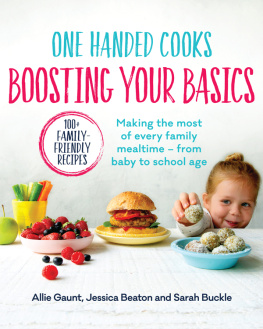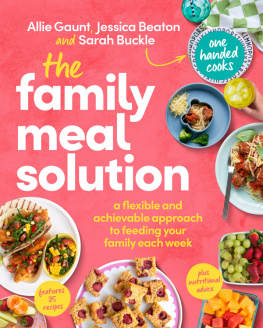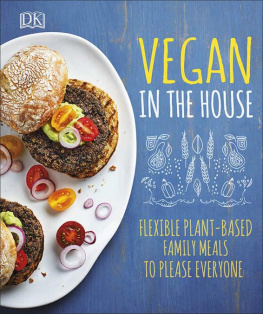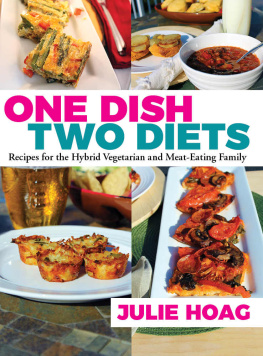One Handed Cooks is a baby, toddler and family food website that features a wide range of simple, healthy and clever recipes to help parents make food a source of enjoyment and nourishment for their children. Written with an Accredited Practising Dietitian (APD) as part of the team, it also offers friendly and realistic nutrition information, as well as tips and strategies to help manage fussy eating behaviours. They have written a collection of much-loved magazines and in 2016 they published their best-selling, self-titled cookbook One Handed Cooks: How to raise a healthy, happy eater from baby to school age, and have since become an Australian leader in the area of baby, toddler and family food. Join the friendly and engaging One Handed Cooks community on social media and say, Hello.
onehandedcooks.com.au
The content in this book is written in consultation with an Accredited Practising Dietitian, however it must be used as a general guide and not as the only source of information on childrens food and/or nutrition. This book is not intended to dictate what constitutes reasonable, appropriate or best care for your child, nor is it intended to be used as a substitute for the independent judgement of a physician or other qualified healthcare professional. Always discuss any concerns or questions about the health and wellbeing of your child with a qualified healthcare professional.
INTRODUCTION
One Handed Cooks are back, and were super-excited to share our new book, Boosting Your Basics: Making the most of every family mealtime from baby to school age . Following on from our hugely successful debut book One Handed Cooks: How to raise a healthy, happy eater from baby to school age , well once again guide parents through some of the most common fussy eating behaviours and how to best navigate and move on from them. The book contains more than 100 new family-friendly recipes, each boosted to maximise both nutrition and taste.
Once again, were providing the inspiration and ideas that parents need to optimise their familys nutritional intake. Whether its breakfast, lunch or dinner, or maybe the much-loved snacks and sweets in between, we believe every meal is an opportunity to encourage the joy of eating, to discover new flavours and textures, and of course boost these meals with new and nutritious ingredients. By opening up to the possibilities of moderation we can instil a mindfulness in our children which will help them to make healthy choices for themselves now and in the future. We believe they can have their zucchini cake and eat it too!
So how can you make the most of the meals your family does enjoy and then begin to adapt those meals to bring about a more nutritious and varied diet? With our tried-and-tested methods you can start to encourage your child in a supportive and positive way to embrace vegetables, meat, fruit and whole grains. In the process you can enable your child to trust in their own hunger and fullness cues, promoting a natural shift in food preferences.
This book has two main focus points. First, we want to highlight everyday meals that feature regularly on the family table and show you easy food substitutions and additions that can boost the nutrient content in a delicious and healthful way. Were also featuring new meals and recipes that can fit into your regular rotation of family favourites.
We believe in building a positive and healthy relationship between children and food. Eating isnt just about the food but also about introducing structure and routine, and creating happy and enjoyable mealtimes free of pressure and anxiety. And this is where our second focus lies: the importance of family mealtimes, learning to look at our own eating behaviours and attitudes towards food and tuning in to our children and their eating preferences to help expand the variety of foods they eat and enjoy.
THE SHARED FAMILY MEAL
Family mealtimes provide a shared experience that is meaningful and contributes to a childs learning, development and wellbeing. Family tradition. Social connection. Daily structure. Mealtime routine. Sense of security. Enjoyment of food. Healthy habits. Love and respect. Positive eating behaviours. Some of our most treasured memories are of food shared at the table as a family and also of celebrations involving food and eating.
The food shared at family mealtimes is often homecooked, highly nutritious and varied. The benefit of this is that the more exposure children gain to a wider variety of food the more likely their acceptance and enjoyment of that food. Transitioning to shared family meals can be an adjustment for everyone, so careful selection of appropriate meals is important to begin with. Perhaps start with meals you know your kids enjoy and then slowly begin to challenge them with new flavours and textures once they are comfortable and familiar with the routine and expectations of family mealtimes.
Role modelling healthful eating
Theres no better time than a family mealtime to role model positive eating behaviours. We can talk and preach to our children about healthy eating and appropriate table manners until the cows come home but they might not take much notice until they see how we act and behave around food.
Put simply, you teach your child to eat by sitting with them at a family meal, and modelling the way you expect your children to behave at the table is an important part of parenting. When you eat as much as you need, your child will learn to too. When you talk positively about food and eating, your child will too. When you talk about and interact with foods that might be unfamiliar to you, your child will too.
And for busy families where adults often have a later mealtime than their children, having at least one parent or adult carer be present at the table during the childrens mealtime enjoying even a small portion of what the children are having can be really beneficial. From a childs point of view, seeing their parents eat the same food that they have on their plate can be a source of comfort and reassurance, providing greater incentive to try new foods.
Both our words and actions have a direct impact so its important that we learn, at whatever age, how to have a positive relationship towards food and eating. All the tips and strategies in this book aimed at children are also relevant to adults so take what you need and apply them to your own attitudes and behaviours. It can only be helpful to you and your family.
Imitation is a powerful reinforcer
Children like to imitate you. They copy your sounds, your movements, your facial expressions. You smile, they smile; you laugh, they laugh. It is the same with experimenting with different foods and tastes. When they see you happily eating a food thats unfamiliar to them, in a single moment they might decide to take that second bite of the portion on their plate too, and to keep munching. They may have spat it out, but when they saw you show enjoyment of the same food, they carried on. We underestimate the power of role modelling. We should lead by example and our children will see and naturally follow. But one of the most powerful reinforcers is for us as parents and carers to imitate our childs positive eating behaviours and thereby encourage him or her to repeat them.
















